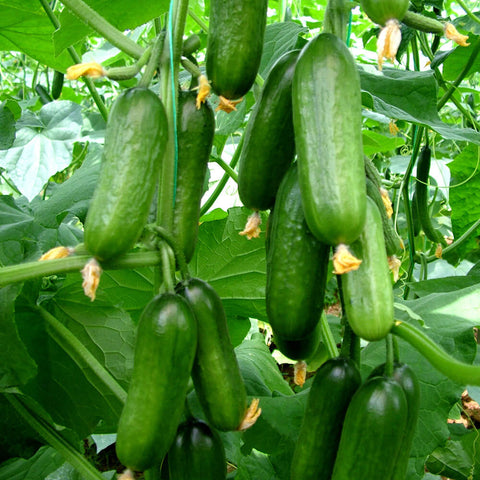

Hortinova
SALAMANDA F1 - Hybrid Cucumber Seeds
Cucumis sativus
- Early maturity.
- Snack cucumber type.
- Fruit length: 10 – 12 cm.
- Crunchy, bitter-free, juicy fruits.
- Vigorous and compact plant.
- High yielding, versatile variety.
- Suitable for greenhouse, raised bed, or balcony cultivation.
- Resistance: CMV, DM.
- Hybrid seeds.
- Natural, Untreated, Non-GMO Seeds.
For best results, sow cucumbers into small pots indoors in mid-to late spring. Poke a hole 1 in (2 cm) deep at the center of each pot and drop in a single seed. Cover with potting mix, water well, label, and place in a clear plastic or propagator. Keep the pots in a warm room (or a propagator) at 68°F (20°C) to germinate.
Seeds can also be sown outdoors into warm soil in early summer. Add plenty of organic matter to the soil beforehand and sow two seeds 1 in (2 cm) deep at each position (so allowing for the failure of one of the seeds). Water well and cover the planting with cloches. Remove the weaker seedling if both should germinate.
POT ON: Seedlings grow rapidly and need to be transferred into 3½ (9cm) diameter pots 7-10 days after they have germinated. Water them well and continue to grow on a warm windowsill at about 51°F (15°C)
SUPPORT: Cucumbers can be grown along the ground if planted 3 ft (90 cm) apart but can be planted closer together (18 in/45 cm apart) if trained up a trellis, cane tripods, or netting to a height of about 6 ft (1.8 m). Supports are best put in place before planting. Tie the main stems onto the supports regularly as they grow.
PLANT OUT: Harden off plants over two weeks by moving pots outdoors for increasing periods. Once the risk of frost has passed, plant in fertile soil in full sun in a sheltered spot. On heavier soils, plant on mounds 6 in (15 cm) high for better drainage. Place the plant into a hole the same depth as the pot, firm soil around the roots, and water well. Cover with cloches. Cucumbers can also be planted into large containers or grow bags.
WATER AND FEED: Water plants growing in the soil weekly and those planted in containers once or twice a day during hot weather. Cucumbers are hungry crops and even those planted directly in the soil will benefit from a regular liquid feed with tomato fertilizer once fruits start to form; plants in containers should be fed twice a week.
POLLINATION: Certain cucumber varieties have separate male and female flowers and therefore require insect pollination in order to produce fruit. Some “all female” varieties are also grown outdoors and will produce bitter cucumbers if pollinated by other varieties: don't grow them together.
Pick cucumbers as soon as they are a usable size by cutting the stem with a sharp knife or pruners. Try to harvest them in the morning when fruits are cool and crisp. They are prolific plants in warm summers, so make pickles for use in winter with any excess fruit.
Let customers speak for us
from 23 reviewsWe grow several varieties of various colours of tomatoes, and the contrast of these tomatoes with other colours is fantastic. We've had a very long season with our plants, excellent disease resistance, great flavour.

This review applies to all of the seeds I purchased from Hortinova - beautiful tomatoes, good disease resistance and excellent production. Our field season extended to 10 weeks. We've had comments of excellent flavour from our customers as well, highly recommend any Hortinova seed.

This tomato is good taste tomato. Small red round tomato. Bigger then cherry tomatoes but smaller then regular one. I like it. Perfect for salads and fresh eating. Ordered seeds for next season.

2nd time ordering. Very satisfied with qualify and result. Thank you

BALCONY YELLOW F1 - Hybrid Cherry Tomato Seeds

Delivered very fast, packed very good, in professional condition and quality. Thanks

DUETT - Open Pollinated Radish Seeds

We will see what they are like this summer.

Type crimson de bonne grosseur avec une superbe uniformité et très hâtif. Un des premiers prêt en saison. Semences très petites et peu nombreuses. Goût très sucré et chaire croquante. Chair passant du rose au rouge en cours de saison. Les plants sont forts et très vigoureux avec des grosses feuilles.

Vigueur des plants impressionante avec des fruits résistants aux fissures et aux dommages. Très bonne conservartion et goût très sucré lorsque les nervures deviennent orange. Peu être récolté lorsque les nervures sont vertes également. Cavité des semences très compacte et petite laissant beaucoup de chair.

Melon qui fond en boûche avec un goût se rapprochant du melon miel et du cantaloup à la fois, très sucré. Faire attention aux irriguations lorsque le melon devient mature car il peut fendre au champs. Très odorant.

Avec son apparence côtellée, son très gros calibre et ça couleur rose, cette tomate se démarque des autres sur les tablettes. Variété plus résistante à la pourriture apicale que la plus part des autres tomates roses. Bon ensemble de résitance aux maladies également.

Tomate noire dont les faces qui ne sont pas exposé au soleil passent du vert au rouge lorsque mature donnant un aspect unique aux fruits. Charactéristiques similaires à la Barrio avec un goût superbe sans acide. Les clients l'on adoré.

Superbe adaptabilité et excellente résistance aux maladies. Fruits uniformes qui ne fendent pas, bonne conservation. Ajoutez à cela un goût unique avec une légère acidité et une pointe sucré.















